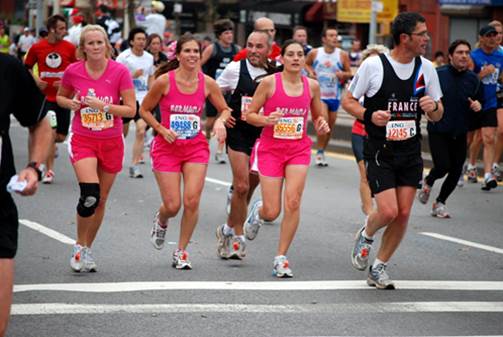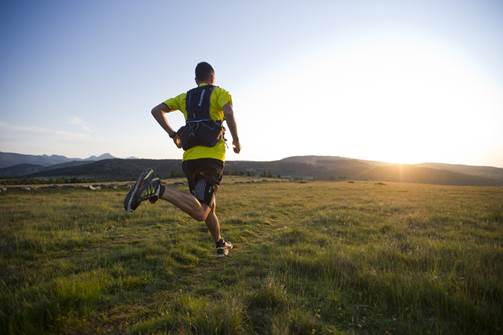Whether you're a first-timer or you
want to improve your PB, we'll help your each your marathon target
For many marathoners, training consists of
running as much as they can, as far as they can, as fast as they can.
Inevitably the result is burnout, injury or dashed expectations. While you do
have to push beyond your limits when you're preparing to run long distances,
there are time-tested methods of doing so that don't involve pain and anguish.

For
many marathoners, training consists of running as much as they can, as far as
they can, as fast as they can
That's where a training plan comes in. At
RUNNER'S WORLD we've been telling people how to safely and successfully -
prepare for marathons for more than 20 years. We tapped a few of our running
superstars - Bart Yasso, RW's chief running officer and veteran of over 100
marathons; editor at large Amby Burfoot, winner of the 1968 Boston Marathon;
and Jennifer Van Allen, the 2008 US National 24-Hour Championship winner for
advice. The schedules and tips over the next six pages are taken from their new
book, The Runner's World big Book of Marathon and Half-Marathon Training.
Key for all marathon schedules
REST Take a
rest day, or do moderate cross-training with a no-impact activity such as yoga
or swimming.
EASY Run at
a comfortable pace. These are interchangeable with rest days. You can
cross-train on an easy day instead with a sustained aerobic effort on a bike or
the elliptical trainer.
HILLS Run
that day's mileage on the hilliest course you can find. Hills build a base of
strength during the first seven weeks of the program.

Take
a rest day, or do moderate cross-training with a no-impact activity such as
yoga or swimming
LSD (beginners) This is a long slow distance run to build endurance and help get
you accustomed to spending time on your feet. Don't worry about your pace
during these runs. Just focus on finishing.
LSD (improvers/advanced) This is a long slow distance run to build endurance. LSDs should be
done at an easy, conversational pace, one to two minutes per mile slower than
your goal race pace. Later in the program, you can practice a fast finish by
picking up the pace during the last two to three miles.
MP These are
runs at marathon goal pace. Practice the speed you're hoping to maintain in the
race. Run one mile easy for a warm-up and one mile easy for a cool-down.
TIME TRIAL A
one-mile time trial can help you track your fitness and set realistic race
goals. Go to a 400m track or any one-mile stretch of road. After a 10-minute
warm-up, time yourself while running four laps (or one mile) as fast as you
can. Note your finish time, then cool down with 10 minutes of walking and
jogging. Over the course of training, your fitness gains will be reflected in
your time-trial results.

A
one-mile time trial can help you track your fitness and set realistic race
goals
STRIDES
Adding strides to any easy run activates your fast twitch muscle fibers, and
improves your coordination and leg turnover, prepping your body for the
marathon. As you get close to the finish of your run, gradually accelerate over
100m until you reach 90 per cent of all-out effort. Hold that effort for five
seconds then smoothly decelerate. Walk to recover between the strides. The
exact distance of each stride is not critical.
HILL REPEATS
Find a hill that will take you at least two minutes to climb, and mark off a
'short' repeat halfway from the bottom and a 'long' repeat at the top. After a
two-mile warm-up, run up to the short mark three or four times, jogging back
down to recover in between. Then run up to the top three or four times, jogging
back down to the short mark and then sprinting to the bottom. (Try to maintain
smooth form, without slapping your feet.) Finish with three or four sprints up
to the short mark. Cool down with two miles of easy running. The total mileage
for the day will amount to about eight miles.
MILE REPEATS
Warm up with two miles of easy running. Run a mile at your 10K pace, jog a lap
(400m) for recovery and repeat that cycle as directed. Cool down with two miles
of easy running.
YASSO 800s
Warm up with two miles of easy running, then run 800m in a time that's 'equal'
to your marathon time. That is, if you're shooting for a 4:10 marathon, try to
run each 800m repeat in 4:10 minutes. Jog 400m in between the 800s. Cool down
with two miles of easy running.
Your debut 26.2
Reach the finish line of your first
marathon with confidence
Key training principles explained
Start slowly and build gradually The prospect of covering the marathon distance can be daunting.
Luckily, you don't have to do it all once. Your body needs time to adapt to
change in mileage or intensity. If you rush that process, you could break down
your body rather than build it up. Coaches have found that the best way to
avoid injury is to follow the 10 per cent rule: increase your weekly mileage
and the length of your long run by no more than 10 per cent each week, it saves
you from injury, and also makes the added mileage more manageable.

Increase
your weekly mileage and the length of your long run by no more than 10 per cent
each week, it saves you from injury, and also makes the added mileage more
manageable
Run easy most of the time About 80 per cent of your runs should be done at an easy pace
that's about 60-90 seconds per mile slower than goal race pace. This should
feel comfortable enough for you to chat while you run. If you're using a heart
rate monitor, you want to be at 65-70 per cent of maximum heart rate. If you're
huffing and puffing, you're going too fast. These miles build muscles, improve
endurance, burn fat and boost blood volume.
Run long every week The long run is the cornerstone of marathon training. It helps you
build endurance, get used to spending time on your feet and practice race
strategy. You'll also get mentally prepared for spending hours running, just as
you'll have to on race day. Beginners should take long runs easy and just focus
on covering the distance feeling strong.
Raise the game
Build on your marathon experience to
run a faster 26.2-miler
Key training principles explained
Hit the hills During the first half of your training, you should include one day a
week of running on a hilly route. Even a small amount of hill work can help you
build leg strength, aerobic capacity and running economy (how efficiently your
body uses oxygen). You won't feel fast going up hills, but you'll feel strong.
Running up an incline places the same demand on your muscles as weight
training: your calves, hamstrings, quads and Glutes have to lift you up the
slope. Add a variety of steep short and long gradual inclines into your
training.
Run at race pace In this training plan, you'll find runs designated as marathon pace
(MP). That way, on the day of your big event, your body will be able to just
dial into it, and it will feel like your body's natural rhythm. The workouts
are also good for the mind - knowing that you've run dozens of miles at race
pace will help you feel more confident.

During
the first half of your training, you should include one day a week of running
on a hilly route
Run fast once a week Running faster once a week is a great way to improve your race
times. It will also build cardiovascular strength because your heart will be
forced to pup harder to deliver oxygen to your leg muscles. And as your legs
and feet turn over at a quicker rate, you'll run more efficiently. With enough
practice, this quicker stride becomes more natural, which means that it'll take
less effort to move faster on any run. There's a mental benefit to speed work,
too: by running closer to maximum pace once a week, your race-pace and easy
runs will feel more comfortable by comparison.